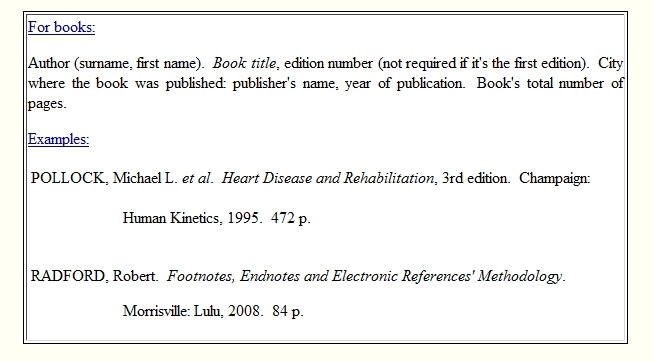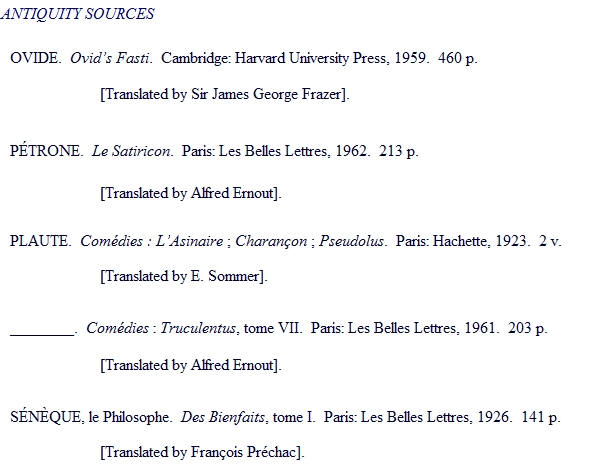HOW TO WRITE IN A PROPER FORMAT: DEFINITION OF A FOOTNOTE
Clicking the
↑ icon displays the top menu
In a text related to social sciences - history, for example -, it is necessary to include footnotes (at the end of the page) or endnotes (at the end of the document, but before the bibliography) in four particular circumstances. But, you can't use both formats in a same document; you either use footnotes or endnotes. Here are the particular circumstances: | ۩ | Whenever you include a quote taken directly from another author's book or article; | | | | | ۩ | Whenever you include one or many statistics (kilometers for a military frontage, number of victims in a conflict, amount of money given by a government, etc.); | | | | | ۩ | Whenever a very precise idea or group of ideas are taken directly and literally from another author's argumentation; | | | | | ۩ | Whenever you include supplementary information allowing you to define or illustrate in more details a concept included to your text. |
|
|
In order to include a footnote or an endnote, we must respect predefined criteria. The criteria can change from one field of study to another. Thus, the format illustrated in this page regards, more particularly, a proper methodology for history papers (theses, essays, synopses, etc.).
Most word processors allow their users to quickly include footnotes or endnotes to their documents. For instance, in Microsoft Word 2003, the user has to click on the "Insert" option of the menu, then on "Reference" and, finally, on "Footnote". |
The notes are in numerical or alphabetical order, but can be of various types as well. Some of you may want to use roman numbers while others will prefer letters, notably. This being said, keep in mind that it is better not to include more than one reference per footnote or endnote and that each note is unique, the next one necessarily being an increased number or letter.
The reference in regard to this first footnote must be fully written, with the exact source:
1- Henry Bogdan, La question royale en Hongrie au lendemain de la Première Guerre mondiale, Louvain : Institut de recherches de l'Europe centrale, 1979, p. 24.
Keep in mind that the name of the author is fully included (first name, then the family name) and that the title is written in italics; some university departments will underline the title instead of putting it in italics. After the title, we must indicate the city where the book was published, the name of the editor, the year it was published and, finally, the page number(s). When the reference is about a page in particular, you shall include "p." but if it regards several pages, you shall indicate "pp.".
If it is an article, the format is different.
2- M.I. Finley, "The Silent Women of Rome", in Horizon, no 7 (1965), Tuscaloosa, Horizon Publishers, p. 64.
As you can see, the title of the article must appear between quote marks, followed by the name of the journal or review in italics. We also must indicate the prefix "in" before the name of the latter. Afterward, we indicate the volume number and/or the date when the article was first published (year, month and day, if it applies), the city where it was published, the name of the publisher and, lastly, we include the page(s) to which the reference is related.
Now, when the reference is repetitive, we can use some predefined terms in order to avoid repeating the full reference over and over again: | ۩ | Ibid.: whenever an identical reference to the previous footnote is used; the page number can be the same or can be different (in which case, you would indicate the different page number); | | | | | ۩ | Idem.: whenever an identical reference to the previous footnote is used (the page number must also be the same). Some will prefer using the term "Ibid.". | | | | | ۩ | Op.cit.: when a book reference has previously been stated as a footnote or an endnote, but not directly before; | | | | | ۩ | Loc.cit.: when an article reference has previously been stated as a footnote or an endnote, but not directly before; |
|
3- Ibid., p. 66.
This "Ibid." makes reference to page 66 of Finley's article, "The Silent Women of Rome".
4- Idem.
In this case, the reference is identical to the previous one (footnote 3): same article, same page (p.66).
5- Bogdan, op.cit., p. 45.
For this fifth reference, I use op.cit. (it is a book), because Bogdan was already cited as a footnote or an endnote but not directly in the previous note (footnote 4). I also must state the page number to which it refers. If many different Bogdan books were previously included as a footnote or endnote, I would have to indicate the name of the book to avoid any confusion: Bogdan, Histoire des pays de l'Est, p. 59.
6- Finley, loc.cit., p. 25.
Same explanation as for footnote 5, but I used loc.cit. instead, because it is an article.
REGARDING ELECTRONIC REFERENCES
↑
When you must include electronic references from Internet websites, you can use several formats. I propose two popular formats you could use in order to respect a proper format: the APA and MLA styles.
APA Style
Family name and first name of the author(s) (year of publication.) Title of the article or of the Internet website (in italic letters). Date you retrieved the information from the website in order to include it to your own document (month, day and year; note thatthis is not required information) and address of the website.
i.e.: Rice, J.C., McBride, R.H. & Davis, J. (1998). Defining a web based learning environment. Retrieved November 5, 2000 from https://www.byu.edu/ipt/workshops/wbi/text.html.
MLA Style
From websites that do not indicate the name of the author(s):
Title of the website in italic letters. Date you retrieved the information from the website in order to include it to your own document (month, day and year) and address of the website in this format:
<source>.
Cyberbee. July 28 2002. <https://www.cyberbee.com>.
From websites where the name of the author(s) is (are) clearly identified:
Family name and first name of the author(s). Date you retrieved the information from the website in order to include it to your own document (month, day and year) and address of the website in this format: <source>.
In example: Radford, Robert. July 28 2002. <https://imperialtometric.com>. |
THE BIBLIOGRAPHY
↑ A few concepts to remember regarding the inclusion of a bibliography to your paper:
|
۩ a bibliography is basically a list of articles, books and/or any other source of information used in order to conceptualize, prepare and write your essay; | |
۩ even if a source was not included to your paper as a footnote, endnote or electronic reference, it must still be added to the bibliography if you consider that this particular source was necessary in your overall understanding of one or more concepts presented in your paper; | |
۩ keep in mind that sources that you did not read by yourself or sources that are not pertinent to your essay must not be included to the bibliography; | |
۩ the bibliography section must appear on a distinct page, at the end of your essay, after the endnotes' section and/or annexes. But, if you included a final section for the presentation of other books you published (or your publisher's other titles), then the bibliography would appear before that particular "From the same author" section; | |
۩ the authors' family names must be included to the bibliography in alphabetical order; | |
۩ the authors' family names must appear as capitalized letters; | |
۩ if a bibliographical reference is from the same author as the previous reference, you can replace the author's name by an underline (this avoids repeating a same name over and over again); | |
۩ if the bibliographical reference requires more than a single line of text, the next lines must have the equivalent of 10%-20% whitespace on the left side (horizontal alignment). This requirement is optional; |
|
|
۩ a bibliography section can be divided in several subsections. Each subsection represents the sources' media type. Hence, we may include subsections for books, review articles and electronic sources, notably. Some also divide their bibliography section as "General Sources" and "Specialized Sources": in such a case, each division could also include subsections for books, review articles and/or electronic references; | |
۩ and once your bibliography section is done and properly included to your paper, it can be a good idea to add a few blank pages. When publishing a book, the publishers usually require such blank pages. This is also true for self-publishing through print on demand (POD) companies such as Lulu, Blurb and
QooP. Remember that the total number of pages must be divisible by four (4) if you decide to publish your essay or book. For example, if your bibliography section ends at page 85, you would have to include three extra blank pages (pp. 86-88). |
Examples of bibliographical references:
Example of a full bibliography:
Examples of other styles for bibliography entries
FREQUENTLY ASKED QUESTIONS
↑
___________________________________ |
Citing a Book Written by Numerous Authors
Citing the Back Cover of a Book
Endnotes' Procedure and Number of
References
Footnote for a Foreword
Footnote Regarding an Expert Author's
Paragraph
Footnotes and Copyright Protected
Documents
Footnotes and Direct References
Footnotes and Punctuation Marks
Footnoting a Citation from a Translated
Book
Numbering and Continuation of Footnotes
Positioning of the Number
Proper Reference for the Transcription of a Conference
Proper Use of the Ibid. Terminology
Quoting a Book's Section Written by a Single Author
Quoting from a Website
Reference for a Scholar's Lecture
Comment # 1:
The following
data was submitted via the electronic form on April 26, 2004:
"I was looking for a
website to explain footnotes to me and yours was the only GOOD
one. Thank you! The only bad thing is that annoying menu thing
that blocks some of the printing...".
Thanks for your kind words.
It is always a pleasure to help people and I'm glad to see you were able to find
the information you were looking for on my website. Regarding the "annoying
menu", I took your comment into account and modified the webpage recently.
Hence, visitors should not have any more difficulties printing the information
included to this website.
Comment # 2:
The following data was submitted via
the electronic form on February 6, 2005:
"Your website is a godsend, thank
you so much. Your website is the only
good one that actually explains
footnotes and endnotes clearly. Can you
please get rid of the Menu? It's really
annoying and it blocks some of the
text".
I'm glad to see you were
able to find answers to your questions on my website. I took good note of
your remark regarding the infamous "Menu" and, as you can see, I decided to
delete it once and for all. Hence, the visitors shall not have any more
problems with it. I did have technical problems with the comments' form
though and had to take it off from the webpage temporarily... This being said,
visitors can still reach me by
email.
Comment
# 3:
The following data was submitted
via email on February 12, 2005:
"Thanks for taking
your time to provide information on footnotes. Your
website answered all my questions and was a pleasure to use. Bonnie".
Comment
# 4:
The following data was submitted
via the electronic form on June 15, 2005:
"Thank you so much for rescuing me in a pinch. I have been out of college a long
time and needed to help someone with a paper. It was great to be able to go to a
website and quickly get the info. Your commentary was also a good read.
Thanks".
The following data was submitted
via the electronic form on December 20, 2005:
"Dear Mr.
Radford,
Hello, my name
is Rachel. I'm an eight grader, and I needed to figure out
how to use footnotes for my thesis paper. Your website was
the only one that clearly answered my questions and thanks
to you, my teacher gave me an extra 15 points for using
footnotes correctly!!! Thanks again!!! Merci beaucoup!!!".
Good
day Rachel,
Thank
you for visiting my website on footnotes and for your good
words. I am very happy to know that my examples helped you
get more points on your paper :). It is also very pleasant
to receive feedback from my website's visitors...
Best regards!
The following data was submitted
via email on September 7th, 2008:
"Good morning
from Ireland,
Go raibh
me maith agat (thank you very much,
literally may you have a thousand good
things). Your website and service are
fantastic resources for those of us
attempting to enter the world of academia!
Tabhair aire
Antin".
The following data was submitted
via the contact form on October 23rd,
2011:
"Thanks for hosting a page dedicated to
writing footnotes/endnotes... I agree
with several of the other comments here,
I'd be so lost without it! You need more
praise. :)".
From : whitney********@hotmail.com
|
|


















